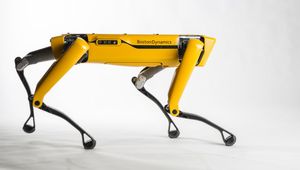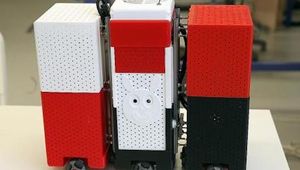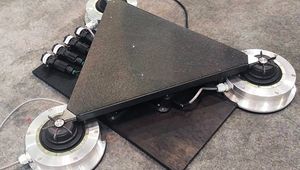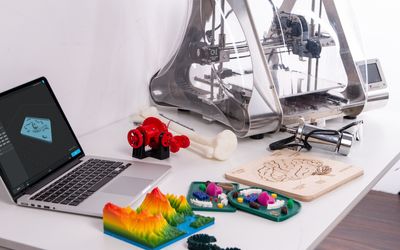Open-Source Grinding Machine for Compression Screw Manufacturing
An open-source grinding machine for making compression screw used for DRAM.
Technical Specifications
| 3D printer | Desktop FFF 3D printer |
| 3D printed parts | Material: PLA filament ~1 kg |
| PLA print parameters | 30% gyroid infill, 4 perimeters, 5 top layers, and 4 bottom layers |
| TPE print parameters | 6 perimeters at 100% gyroid infill |
| Wood router | CNC wood router |
| Work area: 20x20 inches/ 500x500 mm | |
| End mill: 3175 x 17 mm compression wood | |
| Frame | Material: plywood |
| Size: 450 x 201.20 x 278.025 mm | |
| Conduit Hardware | Length: 49.5 inches |
| Angle grinder | Milwaukee 2680 angle grinder |
| Grinding wheel | Type 27 ceramic grinding wheel |
| Size: 4.5 inches | |
| Thickness: 0.25 inches | |
| Capabilities | 16 mm diameter round stock |
| Three types of steel tested | 1045 steel, 1144 steel, and 416 stainless steel |
Overview
This tech spec was submitted by Joshua Pearce as part of the University Technology Exposure Program.
Problem / Solution
With the rise of 3D printing applications in recent years, there will be an increased amount of waste polymers. If left unattended, environmental problems such as landfill accumulation and product pollution will harm society. As of now, waste polymers from direct 3D printing can be recycled through distributed recycling and additive manufacturing (DRAM), which uses either fused particle fabrication (FPF) or Granular fabrication (FGF). The process includes compression screws force post-consumer waste plastic through a heated nozzle for direct 3D printing. Currently, commercially available compression screws are expensive and unsuitable for handling larger pellets because they are small-scale.
A cost-effective and replicable open-source grinding machine for compression screw manufacturing that has the capability to recreate commercial screws and provide flexibility to produce custom screws. The open-source grinding machine runs with an FPF/FGF technical system through the use of a self-replicating rapid prototype (RepRap) methodology. This technology enables operators to cut custom screws by managing the following parameters: channel depths, screw diameters, screw lengths, pitches, abrasive disk thicknesses, the handedness of the screws, and materials (1045 steel, 1144 steel, and 416 stainless steel).
Design
An open-source grinding machine is based on the common lathe machine design in wood and metal working. The components in the grinding machine are chosen based on their functionality and cost efficiency. Further, the technology's design files are set parametrically to allow custom pipe sizes per region to be created.
This technology consists of 3D printable parts produced by Luizbot Taz 6 (FAME 3D, Fargo, ND, USA). Using Polylactic Acid (PLA) and thermoplastic elastomer, operators can print 3D-printed components on desktop 3D Printers. Polylactic Acid print parameters use 5 top layers. 4 bottom layers, and 4 perimeters at 30% gyroid infill. Meanwhile, thermoplastic elastomers use 6 perimeters at 100% gyroid infill.
The 3d Printed Sliders are classified into X-axis sliders for horizontal linear motion and Y-axis for vertical linear motion. This component consists of a Y-axis tuber lower mount and a Y-Axis tube top clamp for mounting and securing y-axis pipes. The component comprises a threaded rod tension slide for mounting pillow block flange, a probe mount to hold the threaded rod, and a threaded rod coupler for connecting x-axis sliders and securing two nuts and springs.
Moreover, the grinding machine is composed of a grinder mount angle that positions the angle grinder to match the helix angle of the screw. The machine is mounted with an M18 bracket, specifically Milwaukee 2680 angle grinder, and different brackets can be developed for other grinder models. Also, this machine uses a quick-release lockdown lever and quick-release bridge clamp to secure and lever the angle grinder tool mount. A lock-side grinder mount is added to the design to hold the quick-release lockdown lever.
The machine is equipped with a profile mount to secure two different profiles for machining. The machine is capable of moving the face of the profile to control the channel depth of the screw using the probe on the y-axis slider. Also, it consists of a chuck pulley and threaded rod pulley, which controls the pitch of the screw. The open-source grinding machine is designed with a belt that connects the chuck and threaded pulleys.
Alongside the grinding machine features, the plywood machine frame is manufactured and chosen for its cost-effectiveness and ability to satisfy the dimensional constraints of the 3D printer. To reproduce the machine's frame, a CNC wood router with a 500x500 mm cutting area can be used to create the plywood parts. Once the plywood parts are created, wood glue will be applied to contact areas. The glued plywood parts will be pressed together through driving wood screws and clamping the two boards together. Lastly, the plywood pieces will be glued chuck end, the free end, and the back cross-section.
References
A research paper describing the challenge, design, and outcome of the research.
Recommended Specs
Continue Reading
Combining SLA 3D printing and soft lithography for fast, versatile, and accessible high-resolution fabrication of customised multiscale cell culture devices with complex designs
Taking advantage of low-cost, high-resolution desktop resin 3D printers combined with PDMS soft-lithography we have developed an optimised microfabrication pipeline capable of generating a wide variety of customisable devices for cell culture and tissue engineering in an easy, fast reproducible way








